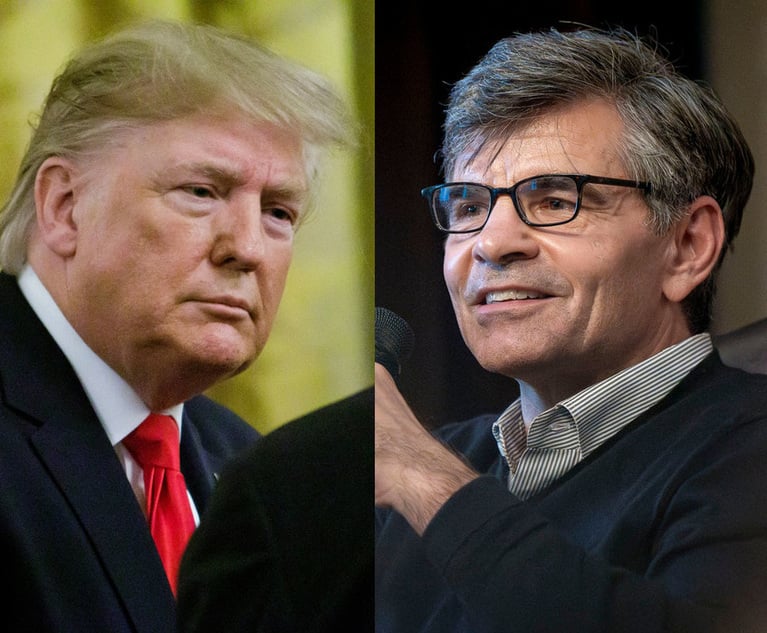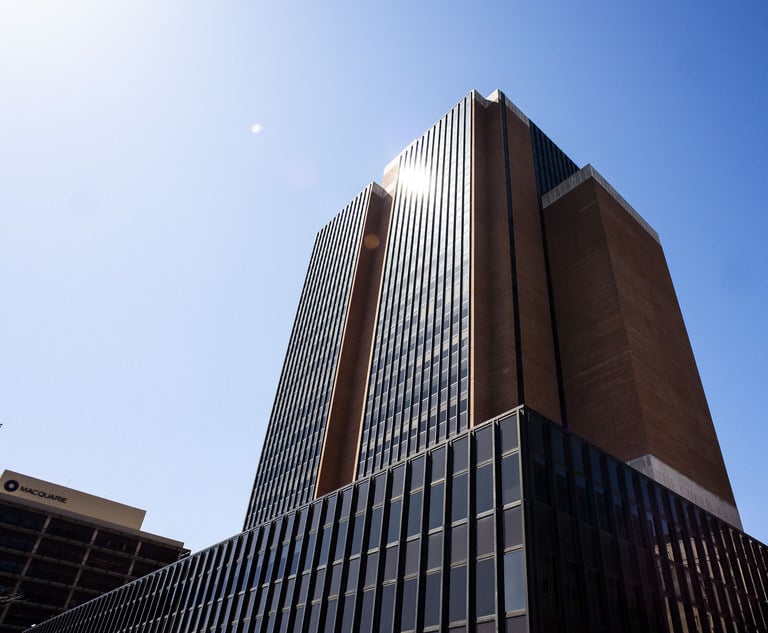Trump's Social Media Order Puts a Target on Communications Decency Act
How this order could possibly withstand judicial scrutiny under the public forum doctrine is dubious. And how compelling a publisher to speak is different from a mandated flag salute is unclear.
June 14, 2020 at 09:00 AM
7 minute read
 Credit: quka/Shutterstock.com
Credit: quka/Shutterstock.com
President Trump's recent war with Twitter—his primary mode of expression—blew up recently after the social-media platform tagged the president's claims about fraud in mail-in balloting as misleading and offered readers the chance to click on a link to see contradictory evidence. Soon after, Twitter doubled-down on its efforts when it placed a warning label over messages from both the President and the White House's Twitter accounts which implied that looters at the Minneapolis protests could be shot, saying the tweets violated the site's policies against glorifying violence.
The president, meanwhile, used Twitter to accuse the platform of "interfering in the 2020 Presidential Election" and "stifling FREE SPEECH." Around the same time, the White House began leaking various versions of an executive order which threatened to narrow legal protections for platforms that censor speech for ideological reasons, and he made it clear that he would seek to punish Facebook, YouTube and other platforms which allegedly interfere with his ability to communicate directly with his followers.
The "Executive Order on Online Censorship," as it calls itself in its final version, attempts to harness executive power to undermine a law passed by Congress that has been the bedrock of free speech on the Internet for almost 25 years. During that time, courts have almost uniformly reinforced the immunity provided from defamation and other torts to Internet providers by Section 230 of the Communication Decency Act of 1996. Section 230, designed to allow growth of the then-nascent Internet by providing protections from suit similar to that provided to newsstands, has made it virtually impossible to sue an online provider for the defamation of someone posting on its pages.
Of course, even the most zealous First Amendment advocate would have to concede that the law has created an atmosphere of impunity on an enormous scale, as posters, tweeters and bloggers go wild with lies, misinformation, and hate speech, despite their continued potential for being sued. Just as these various platforms—without fear of such lawsuits—have grown exponentially, calls for policing inciting speech, misinformation, sex trafficking and foreign posts designed to divide our electorate– have increased sharply.
As a result, in more recent years there have been multiple calls—even from its original sponsors—to amend or repeal Section 230 from both right and left. Basically, many Democrats—even assumed Democratic candidate Joseph Biden—have called for repeal of the law—maintaining that it propagates hate speech, divisive rhetoric and abuse. Many Republicans, meanwhile, feel that the Internet platforms, particularly Twitter and less so Facebook, have attempted to censor their speech, mostly by banning many of their most popular fringe figures from the platforms, such as Alex Jones, Laura Loomer, Milo Yiannopoulos and white nationalist and former congressional candidate Paul Nehlen.
Section 230 has two primary provisions creating immunity from liability. First, Section 230(c)(1) says that an information service provider shall not be treated as a "publisher or speaker" of information from another information content provider. Courts have broadly interpreted this section to bar suits against a provider as if they were the publisher in both negligence and discrimination cases as well as defamation. Thus, you can sue person who wrote the post (if you can identify them) but you cannot sue the publisher as if they were the speaker.
Section §230(c)(2), the "Good Samaritan" provision, was actually meant to encourage internet providers to take down materials they deem "obscene, lewd, lascivious, filthy, excessively violent, harassing, or otherwise objectionable, whether or not such material is constitutionally protected"; as long as they act "in good faith" they are provided with immunity from civil liabilities for doing so. The first section applies when providers refrain from filtering or censoring their sites, and the second section provides a qualified immunity based on good faith. Although certain types of cases like federal criminal cases, electronic privacy violations and intellectual property claims are exempted, in general the law provides immunity for the platforms from inconsistent state criminal laws.
If both candidates for president want to amend, restrict or repeal the law, what's the difference between what Biden wants to do and what the president is trying to accomplish in his executive order? The difference appears to be that Biden would hold social media companies accountable for knowingly allowing falsehoods on their platforms, leading to more moderation of misinformation, rather than less, but it may also lead to a chill on speech when providers are forced to restrict what can be said in order to avoid liability.
The president's position appears to be that everyone should be allowed to say whatever they want without any censorship—misinformation or not—and he claims that the Internet platforms are essentially public platforms that are regulated by the First Amendment. Given the platforms' history of going easy on the President, his swift reaction to Twitter's edit had him raising the only sabre he could without an act of Congress.
With that limitation, the executive order plays around the edges while making its targets very clear to the platforms and the president's base. Complaining that such censorship, even of misinformation, is "un-American and anti-democratic," the order attacks the size and power of the platforms, claiming "selective censorship" imposed in an "inconsistent," irrational and groundless" manner, specifically criticizing the warning labels Twitter placed on the president's tweets. (In reality, Twitter was enforcing its existing rules prohibiting misinformation related to the voting process and prohibiting glorifying violence. Twitter didn't censor or ban The president or take down his tweets. It placed a small disclaimer on two of them—a pair of baseless tweets stating that mail-in ballots were ripe for voter fraud—and put a warning label the other).
While the order is the culmination of long-standing grievances by the right against the platforms, particularly Twitter and YouTube, the order has dubious legal footing and little immediate practical effect except perhaps intimidation. It instructs the Federal Trade Commission (FTC) to review potential cases of anti-conservative bias on behalf of social media platforms under its authority to sanction companies that engage in unfair or deceptive acts or practices. It directs the Commerce Department to petition the Federal Communications Commission (FCC) to reexamine the scope of Section 230 of the Communications Decency Act. But more worrisomely, it opens the platforms to additional investigations by ordering the Justice Department to perform an assessment of whether "any online platforms are problematic vehicles for government speech due to viewpoint discrimination, deception to consumers, or other bad practices," and instructs the attorney general to propose legislation "useful to promote the policy objectives of this order." How this order could possibly withstand judicial scrutiny under the public forum doctrine is dubious. And how compelling a publisher to speak is different from a mandated flag salute is unclear.
The juxtaposition of the order to the president's spat with Twitter makes it clear this was a shot across the bow for attempting to correct the President's Tweets. It may also reflect a reaction to the D.C. Circuit's short-shrift dismissal that same week of the case Freedom Watch and Laura Loomer v. Google, et al, which had alleged the three platforms and Apple conspired to suppress conservative political views, violating the First Amendment along with antitrust and human rights laws. With a written shrug, the court made plain that the lawsuit fails because the First Amendment only addresses government abridgment of speech and does not apply to these private platforms.
Yet with both parties clamoring for some change—albeit for different reasons—the future of the free-for-all we call the Internet may soon drastically change, and along with such a change, it is very possible that a lot of important speech, along with plenty of misinformation, hate and abusive speech could be eliminated or curtailed because of the platforms' fears of liability. No one who reads or posts on the Internet would be quite prepared if that change were to come. The question for all of us in 2021 will be, is do we want to throw out the baby with some very dirty bathwater?
This content has been archived. It is available through our partners, LexisNexis® and Bloomberg Law.
To view this content, please continue to their sites.
Not a Lexis Subscriber?
Subscribe Now
Not a Bloomberg Law Subscriber?
Subscribe Now
NOT FOR REPRINT
© 2025 ALM Global, LLC, All Rights Reserved. Request academic re-use from www.copyright.com. All other uses, submit a request to [email protected]. For more information visit Asset & Logo Licensing.
You Might Like
View All
Bankruptcy Judge Clears Path for Recovery in High-Profile Crypto Failure
3 minute read
ABC's $16M Settlement With Trump Sets Bad Precedent in Uncertain Times
8 minute read
3rd Circ Orders SEC to Explain ‘How and When the Federal Securities Laws Apply to Digital Assets’
5 minute read
Trending Stories
- 1States Accuse Trump of Thwarting Court's Funding Restoration Order
- 2Microsoft Becomes Latest Tech Company to Face Claims of Stealing Marketing Commissions From Influencers
- 3Coral Gables Attorney Busted for Stalking Lawyer
- 4Trump's DOJ Delays Releasing Jan. 6 FBI Agents List Under Consent Order
- 5Securities Report Says That 2024 Settlements Passed a Total of $5.2B
Who Got The Work
J. Brugh Lower of Gibbons has entered an appearance for industrial equipment supplier Devco Corporation in a pending trademark infringement lawsuit. The suit, accusing the defendant of selling knock-off Graco products, was filed Dec. 18 in New Jersey District Court by Rivkin Radler on behalf of Graco Inc. and Graco Minnesota. The case, assigned to U.S. District Judge Zahid N. Quraishi, is 3:24-cv-11294, Graco Inc. et al v. Devco Corporation.
Who Got The Work
Rebecca Maller-Stein and Kent A. Yalowitz of Arnold & Porter Kaye Scholer have entered their appearances for Hanaco Venture Capital and its executives, Lior Prosor and David Frankel, in a pending securities lawsuit. The action, filed on Dec. 24 in New York Southern District Court by Zell, Aron & Co. on behalf of Goldeneye Advisors, accuses the defendants of negligently and fraudulently managing the plaintiff's $1 million investment. The case, assigned to U.S. District Judge Vernon S. Broderick, is 1:24-cv-09918, Goldeneye Advisors, LLC v. Hanaco Venture Capital, Ltd. et al.
Who Got The Work
Attorneys from A&O Shearman has stepped in as defense counsel for Toronto-Dominion Bank and other defendants in a pending securities class action. The suit, filed Dec. 11 in New York Southern District Court by Bleichmar Fonti & Auld, accuses the defendants of concealing the bank's 'pervasive' deficiencies in regards to its compliance with the Bank Secrecy Act and the quality of its anti-money laundering controls. The case, assigned to U.S. District Judge Arun Subramanian, is 1:24-cv-09445, Gonzalez v. The Toronto-Dominion Bank et al.
Who Got The Work
Crown Castle International, a Pennsylvania company providing shared communications infrastructure, has turned to Luke D. Wolf of Gordon Rees Scully Mansukhani to fend off a pending breach-of-contract lawsuit. The court action, filed Nov. 25 in Michigan Eastern District Court by Hooper Hathaway PC on behalf of The Town Residences LLC, accuses Crown Castle of failing to transfer approximately $30,000 in utility payments from T-Mobile in breach of a roof-top lease and assignment agreement. The case, assigned to U.S. District Judge Susan K. Declercq, is 2:24-cv-13131, The Town Residences LLC v. T-Mobile US, Inc. et al.
Who Got The Work
Wilfred P. Coronato and Daniel M. Schwartz of McCarter & English have stepped in as defense counsel to Electrolux Home Products Inc. in a pending product liability lawsuit. The court action, filed Nov. 26 in New York Eastern District Court by Poulos Lopiccolo PC and Nagel Rice LLP on behalf of David Stern, alleges that the defendant's refrigerators’ drawers and shelving repeatedly break and fall apart within months after purchase. The case, assigned to U.S. District Judge Joan M. Azrack, is 2:24-cv-08204, Stern v. Electrolux Home Products, Inc.
Featured Firms
Law Offices of Gary Martin Hays & Associates, P.C.
(470) 294-1674
Law Offices of Mark E. Salomone
(857) 444-6468
Smith & Hassler
(713) 739-1250






